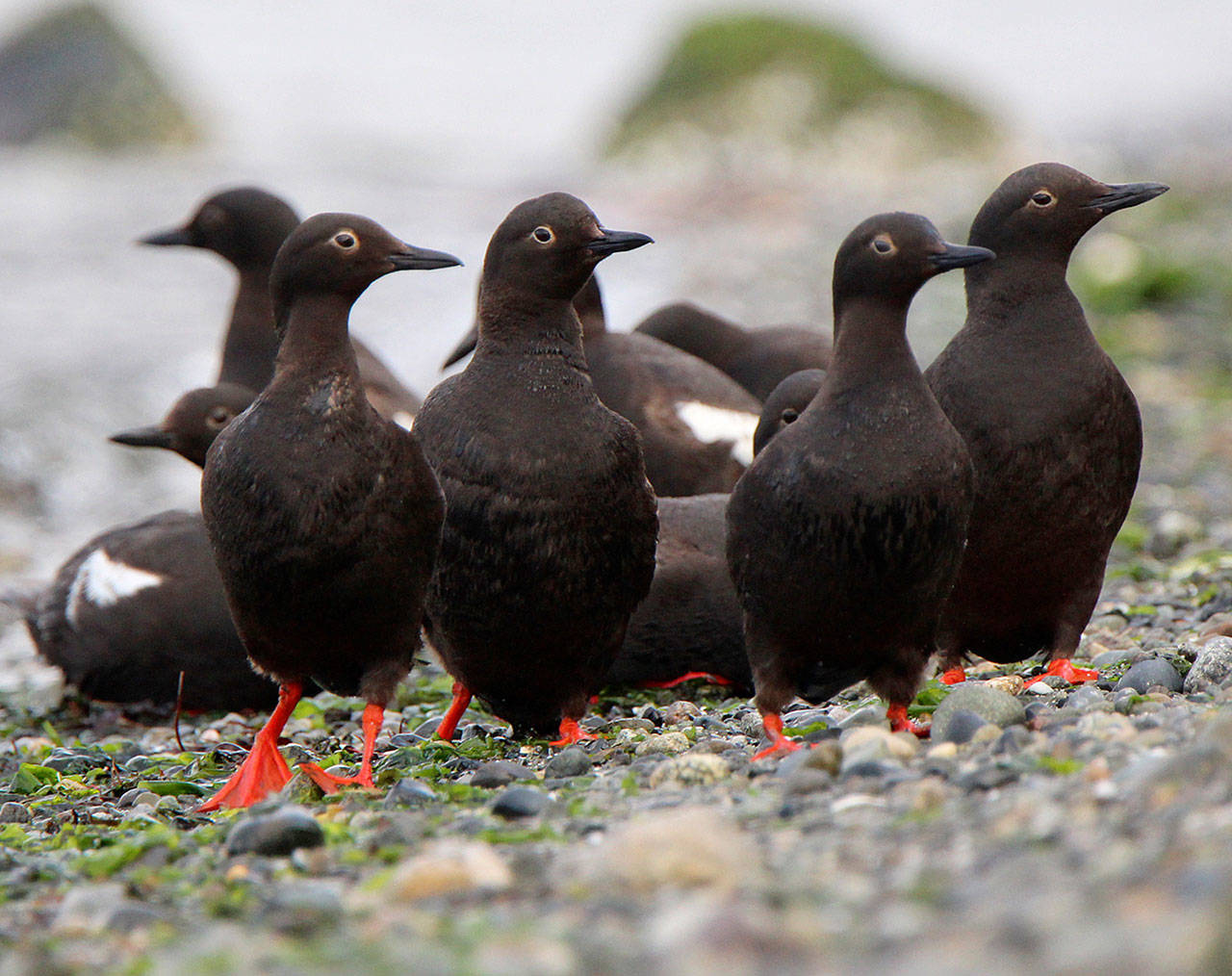For the past 12 years, Frances Wood could be found on early summer mornings a stone’s throw away from one of Whidbey’s many bluffs armed with binoculars and a note card. She, along with roughly 50 other volunteers stationed at bluffs across the island, have worked to closely track the Pigeon Guillemot population compile a data set unlike any other in the Pacific Northwest.
And after more than a decade of observing the small black and white seabirds with vibrant red feet, those early mornings have finally come to fruition.
Wood and other citizen scientists from Whidbey Audubon Society, Sound Water Stewards and from the community recently published their findings on the resident seabird to a peer-reviewed science journal, Northwest Naturalist. It’s a compilation of what they call “base line data” for Pigeon Guillemots on Whidbey Island — population statistics, breeding patterns and feeding habits. The data shows they’re successfully laying eggs in their burrows on Whidbey’s bluffs and whether population numbers are fluctuating.
According to study volunteers, it’s new research for the Pacific Northwest.
“The interesting thing is this is the only long-term study of its kind anywhere in our area,” Wood said. “It grew as interest from the volunteers and greater seabird community around Puget Sound snowballed. Representatives from Washington Department of Fish and Wildlife and bird researchers in the Sound encouraged us to prepare the data for publication.”
Their research found that Pigeon Guillemot numbers that come to Whidbey to nest and breed are stable. There are 25 colonies spread from Clinton to Deception Pass, with about 1,000 of the black and white seabirds calling the island home. The population number naturally fluctuate, Audubon member Ann Casey said, but the bottom line is they’re successfully breeding.
“The important part is those birds are successfully laying eggs and their chicks are successfully fledging,” Casey said. “If they’re not successful, the population will change. We do note some changes in what they’re feeding their chicks, though.”
What makes this data important, volunteers say, is that Pigeon Guillemots are acknowledged as an indicator species by ecological agencies in Puget Sound. Scientists can monitor changes in the Sound’s health by keeping a close eye on Pigeon Guillemot numbers and their reproduction cycles. It’s largely why those who began the study received support and funding from marine conservation and research groups such as Puget Sound Partnership, Island County Marine Resources Committee and Northwest Straits Initiative.
Government agencies such as the Washington Department of Fish and Wildlife and Department of Ecology have also kept a close eye on the study while it developed, and at times have even used it as a reference. Wood says the Department of Ecology used the group’s data on “three or four” colonies around Penn Cove following the oil spill in 2012 to see if their clean- up efforts would reduce the effects on nearby wildlife.
Since the study was published, researchers have already utilized the baseline data set.
“Even though our study was only recently published in December, we’re already finding our study is being referenced in other documents,” Wood said. “We’re now recognized as a part of the greater science community now, which is a serious success for citizen science.”
Similar studies have kick started others across Puget Sound as a result of its success. Wood, Casey and other volunteers have mentored other research groups in places such as Clallam County and South Sound. Whidbey’s citizen scientists have also rubbed shoulders with seabird researchers from around the world after presenting their findings at the International Seabird Conference in Tacoma.
The volunteers were clear that their work shouldn’t be discredited since they aren’t full-time scientists. Wood says volunteers follow a very specific protocol that was established with the help of the department of fish and wildlife. She added many of the volunteers are retirees who have PhDs in marine ecology, and their findings have been widely accepted as legitimate data.
Although the data was published, the work doesn’t stop there. Casey said Whidbey’s citizen scientists finally compiled enough data to publish their work, but it’ll be an ongoing long-term study for the foreseeable future. By the looks of it, the group of volunteers will be fully up to the task.
“We don’t consider it completed, and we’re being encouraged to continue this study as long as there’s funding and interested volunteers,” Wood said. “These birds are my passion and the same can be said about many in this group. I don’t think we’ll have problems getting together a team.”


